2024年新疆乌什7.1级地震和中国台湾花莲7.3级地震前的大震长期平静及中国大陆强震危险性研究
2025-01-02赵小艳苏有锦孟令媛臧阳
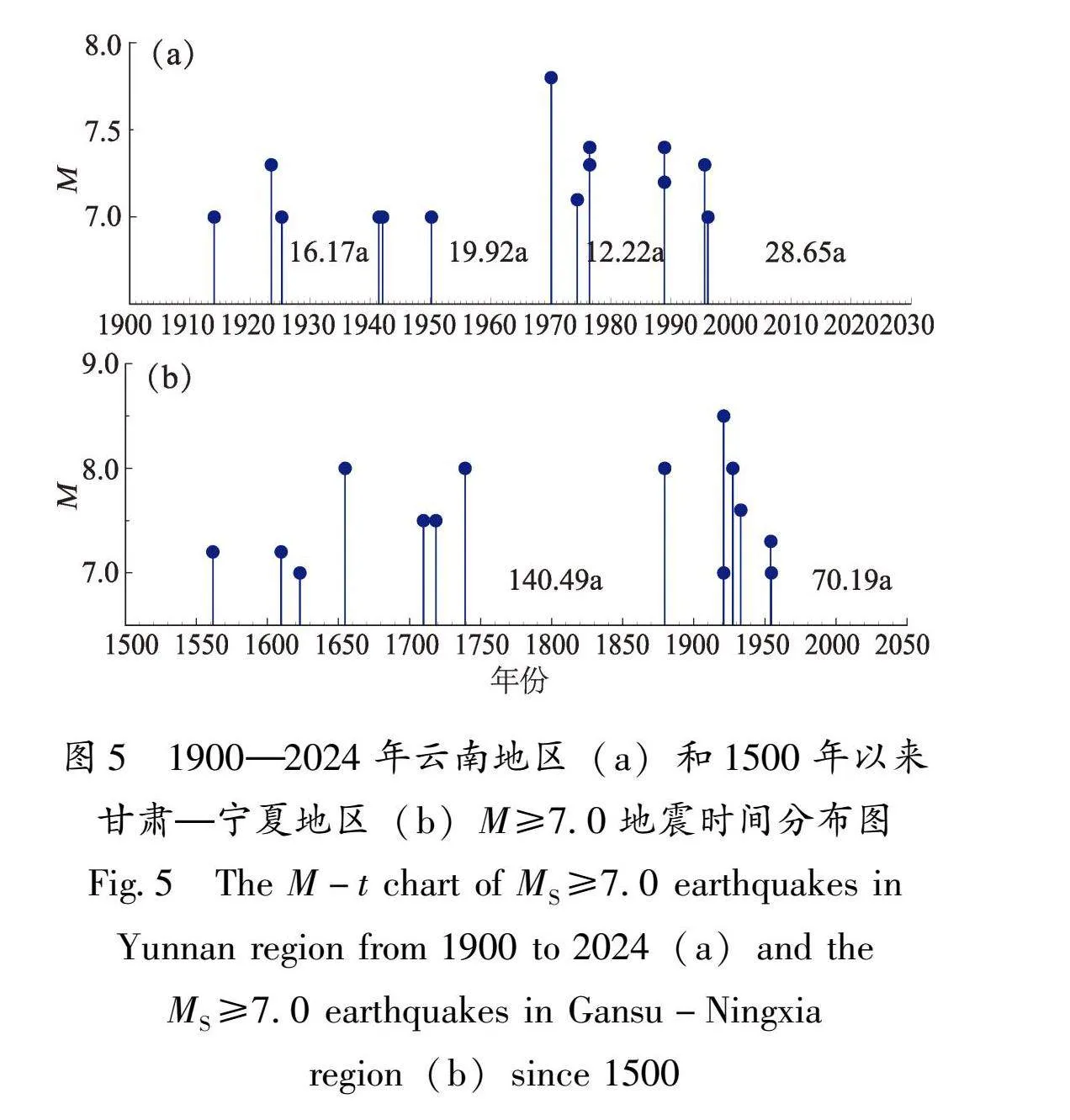
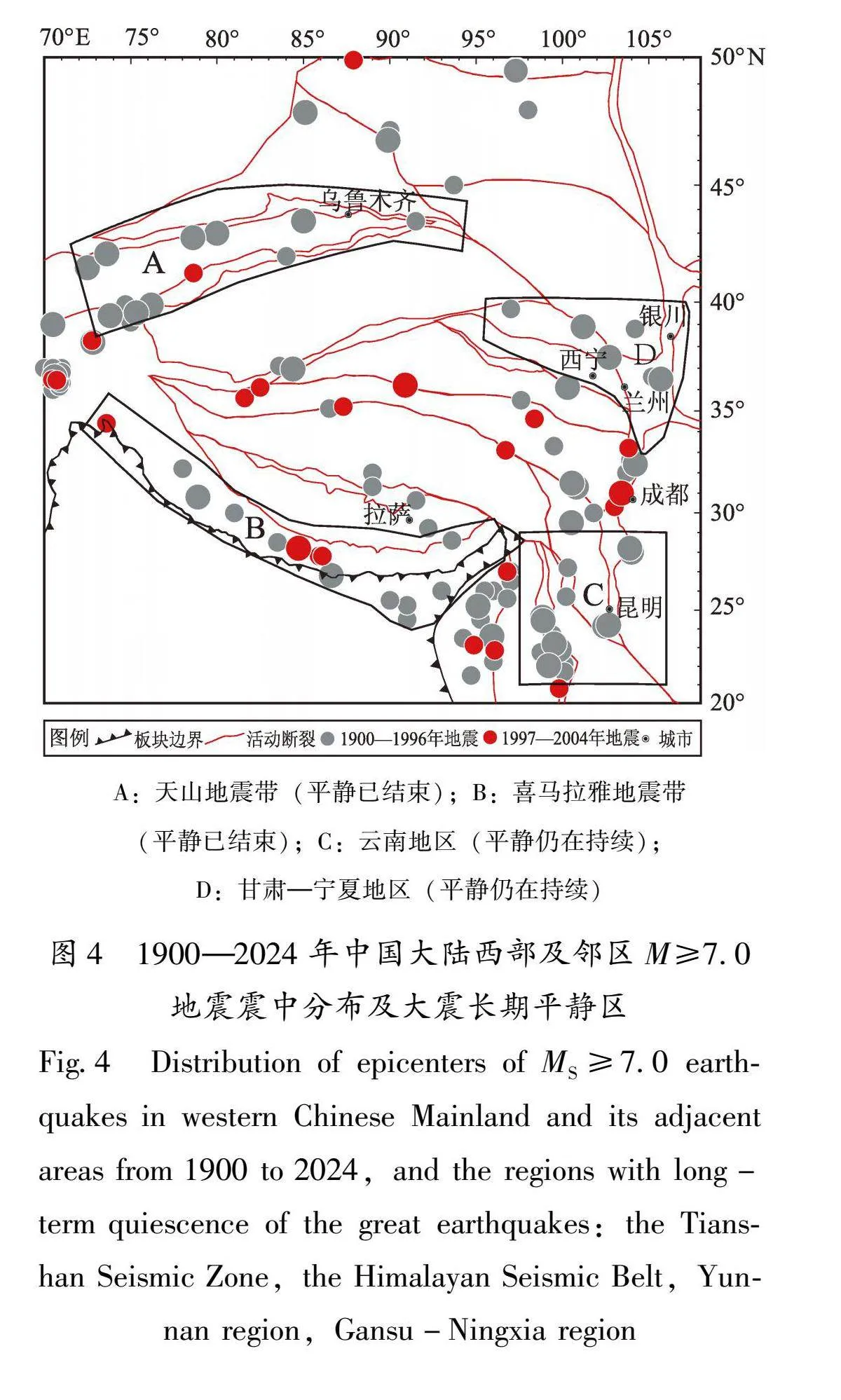
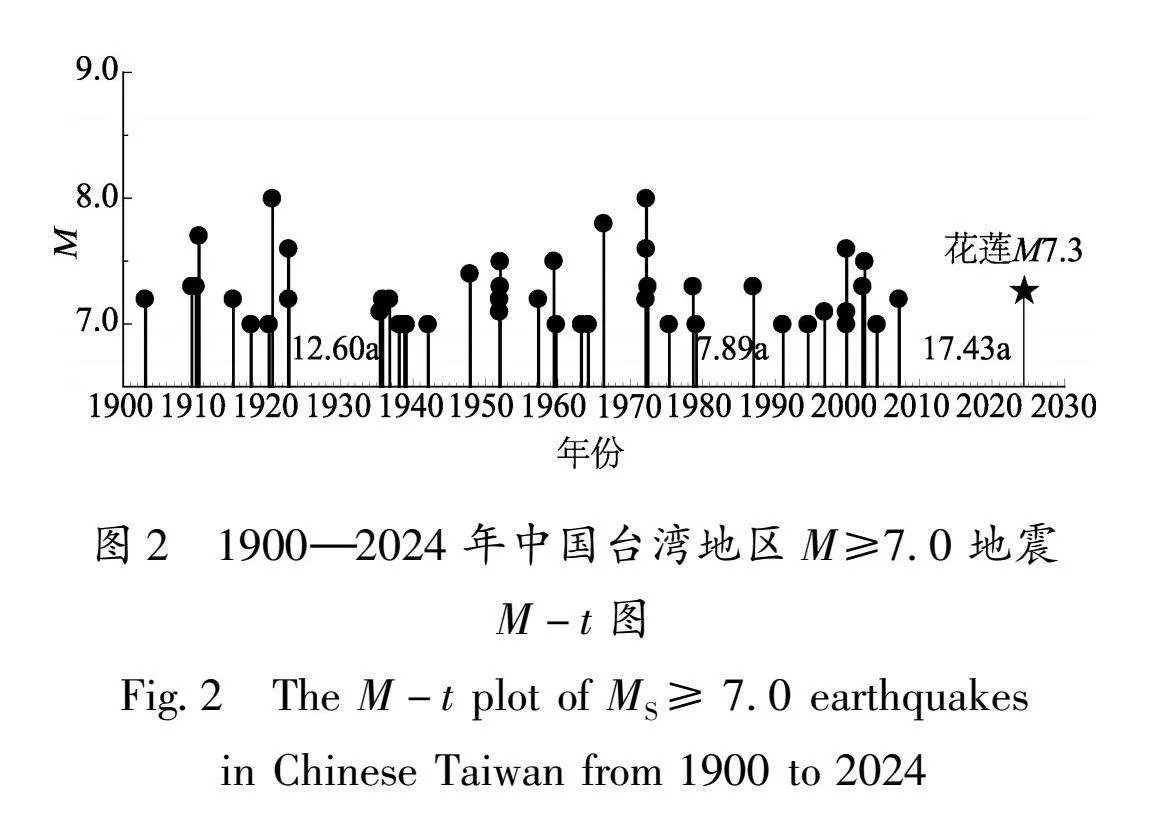
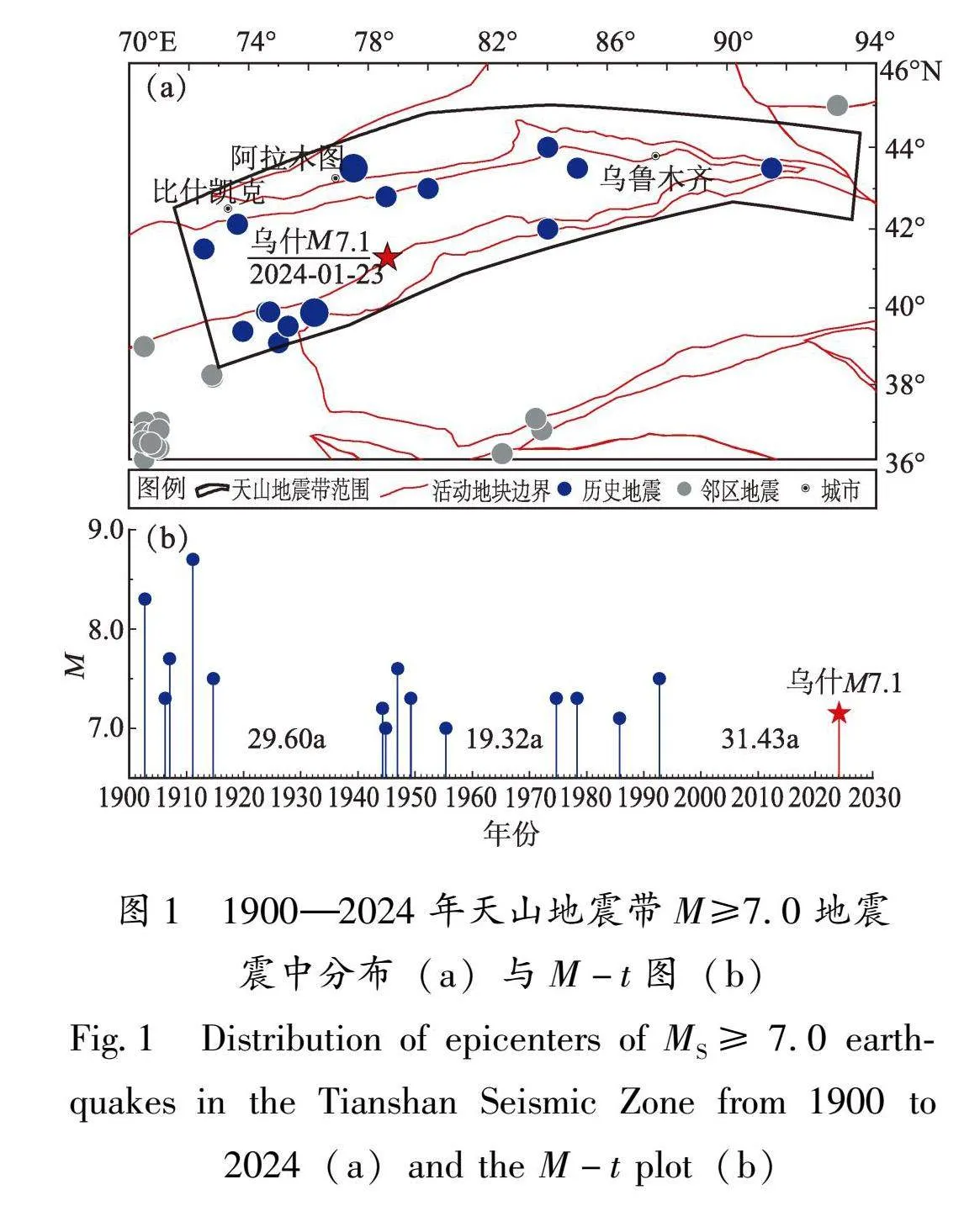
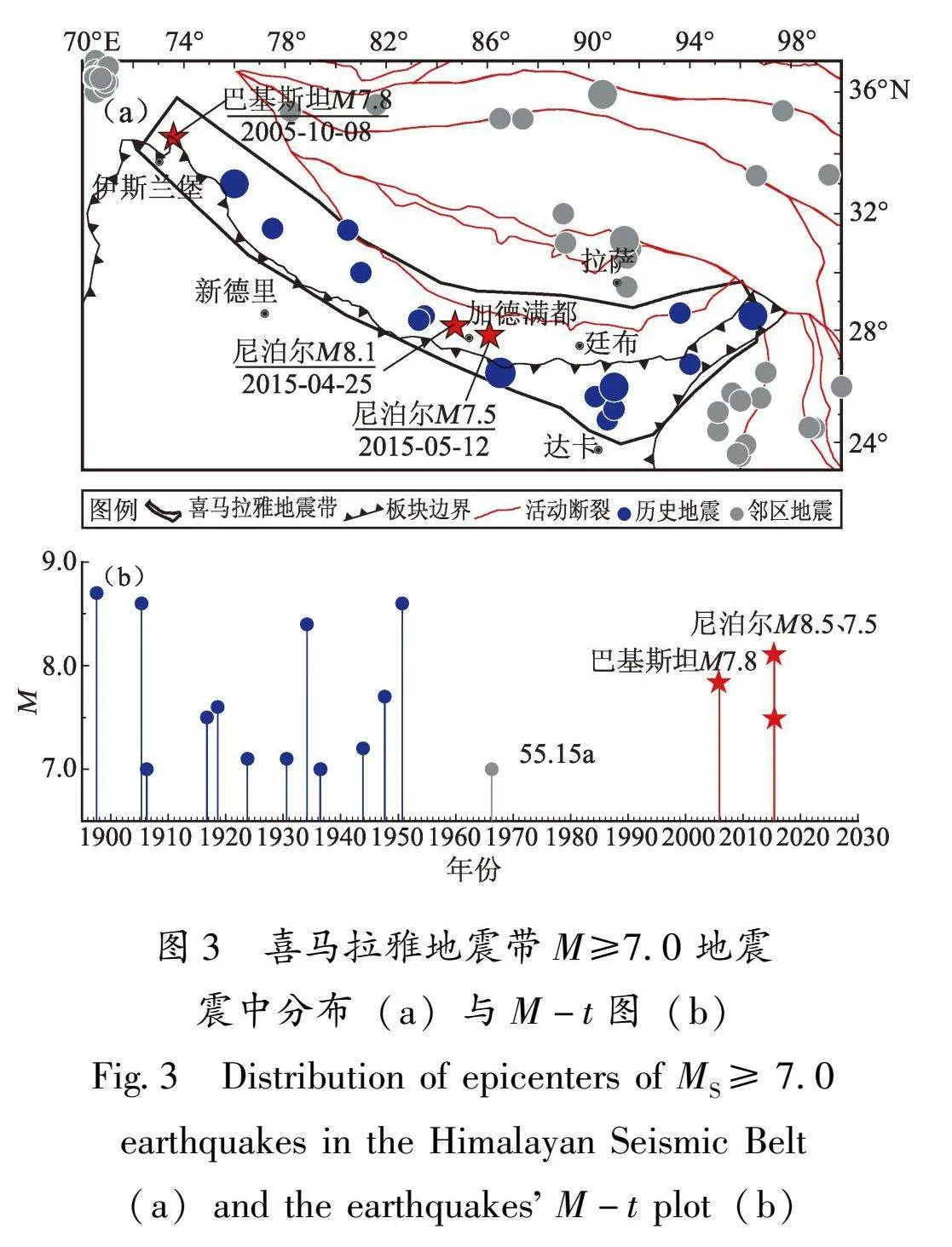
摘要:对2024年新疆乌什7.1级地震和中国台湾花莲7.3级地震前出现的长期地震平静现象及其平静结束后的地震趋势进行了分析,进而对中国大陆当前仍存在的2个大震长期地震平静区域及其危险性进行了分析和讨论。结果表明:①乌什7.1级地震结束了天山地震带长达31年的7级以上地震长期平静状态,可能预示着天山地震带将进入一个新的7级以上地震活跃时段;花莲7.3级地震结束了中国台湾地区长达17年的7级以上地震长期平静状态,可能预示着中国台湾地区将进入一个新的7级以上地震活跃时段。②南北地震带南段的云南地区自1996年丽江7.0级地震以来地震平静时间超过28年,南北地震带北段的甘肃—宁夏地区自1954年内蒙古阿拉善盟阿拉善左旗7.0级地震以来地震平静时间已超过70年,这2个区域当前或未来一个时期发生7级以上地震的风险较高,尤其是云南地震地区,应引起特别的关注和研究。
关键词:乌什7.1级地震;花莲7.3级地震;地震长期平静;南北地震带
中图分类号:P315.72"" 文献标识码:A"" 文章编号:1000-0666(2025)01-0032-09
doi:10.20015/j.cnki.ISSN1000-0666.2025.0004
0 引言
2024年1月23日2时9分,新疆阿克苏地区乌什县(41.26°N,78.63°E)发生7.1级地震,震源深度22 km;2024年4月3日7时58分在中国台湾省花莲县海域(23.81°N,121.74°E)发生7.3级地震,震源深度12 km。新疆乌什7.1级地震结束了天山地震带自1992年吉尔吉斯斯坦7.5级地震以来长达31年的7级以上地震平静;中国台湾花莲7.3级地震结束了中国台湾地区自2006年中国台湾南部海域7.2级地震以来长达17年的7级以上地震平静。我国地震学者一直关注天山地震带和中国台湾地区的大震长期平静现象及其大震危险性,这2次地震均发生在全国年度地震重点危险区内①。
近年来,在多个大震活动区(带)出现了类似平静异常现象,如喜马拉雅地震带、土耳其东安托利亚断层带等。2005年10月8日巴基斯坦7.8级地震的发生结束了喜马拉雅地震带长达55年的7级以上地震平静(薛艳等,2015;);2023年2月6日土耳其7.8级地震的发生结束了土耳其东安托利亚断层带长达130年的7级以上地震平静(Carena et al,2023;Hayrullah et al,2023)。因此,对一些历史强震(大震)活动带、区,出现的长期地震平静现象及其地震危险性预测意义,应引起特别的关注和研究。
地震活动性研究是地震预测的一个重要方面,强震活动期幕特征和地震空区理论的应用是目前开展大震活动趋势预测和危险性评估的主要技术途径和方法。已有研究表明,不同时空尺度地震活动时、空丛集特征(时、空非均匀性)是一个普遍存在的基本特性,即在空间上呈带、区分布,在时间上具有活跃和平静交替的特性(张培震等,2003,2013;邓起东等,2014;M7专项工作组,2012;邵志刚,张浪平,2013;苏有锦等,2024;Katsumata,2016;薛艳等,2015;Gupta,2015)。地震空区理论认为,板块边界或板内构造边界地震带上出现的大地震破裂空段,是未来大震的发生地点(McCann et al,1979;Nishenko,1991)。近年来,许多大地震、特大地震都发生在依据“地震空区理论”判定的地震空区内(Gupta,2015;Carena et al,2023;Hayrullah et al,2023;Zhao et al,2023;Zhang et al,2023a)。
基于《中国历史强震目录》(公元前23世纪至1911年)和《中国近代地震目录》(1912—1990年)(国家地震局震害防御司,1995,1999),《全球地震灾害信息目录(9999B.C.—2010A. D.)》(宋治平等,2011),整理了本文研究使用的地震目录资料;本文结合天山地震带和中国台湾地区历史地震活动特征,对2024年新疆乌什7.1级地震和中国台湾花莲7.3级地震前的长期平静现象及其平静结束后的地震趋势问题进行了分析研究,进而对中国大陆当前仍存在的大震长期平静区域及其大震危险性进行了分析讨论。
1 乌什7.1级地震结束了天山地震带长期7级以上地震平静
天山(天山造山带)是印度板块和欧亚板块碰撞、挤压汇聚吸收的北西运动分量的主要释放区域,区内断裂构造十分发育,地震活动非常强烈(张培震等,1996;Deng et al,1996;Molnar,Ghose,2000;Tapponnier et al,2001;Wang et al,2004;Lu et al,2018;Wang,Shen,2020;Zhang et al,2023b)。天山地块是一个二级活动地块,其南、北两侧边界带均以前陆盆地的褶皱和逆冲断裂为主,强震主要发生在活动褶皱和逆冲断裂带附近(张培震等,2003,2013)。
图1为1900—2024年天山地震带M≥7.0地震震中分布和时序分布图。由图1a可见,1900—2024年,天山地震带发生M≥7.0地震15次(其中7.0~7.9级地震13次,8.0级以上地震2次),在时间分布上呈现明显的活跃-平静交替发生的分期特征(薛艳等,2004;曲延军等,2008)。由图1b可见,1900—2024年天山地震带已出现了3个活跃期和3个平静期。第Ⅰ活跃期为1902年8月22日至1914年8月5日,持续11.96年,发生M≥7.0地震5次(年发生率为0.42),最大为1911年哈萨克斯坦阿拉木图8.7级地震;第II活跃期为1944年3月10日至1955年4月15日,持续11.10年,发生M≥7.0地震6次(年发生率为0.55),最大为1946年吉尔吉斯斯坦7.6级地震;第III活跃期为1974年8月11日至1992年8月19日,持续约18.02年,发生M≥7.0地震4次(年发生率为0.22),最大为1992年吉尔吉斯斯坦7.5级地震;3个活跃期平均持续时间为(13.67±3.77)年。3个平静期分别为1914年8月6日至1944年3月9日(持续29.60年)、1955年4月16日至1974年8月10日(持续19.32年)和1992年8月20日至2024年1月22日(持续31.43年);平静期平均持续时间为(26.78±6.53)年。
2024年1月23日乌什7.1级地震发生在塔里木地块西北缘与天山南缘断陷褶皱带交会处,震中位于迈丹—沙依拉姆断裂带附近。该断裂带总体走向为NE-NEE,以左旋走滑逆冲运动为主,内部发育有多条近平行分布的次级断裂(邓起东等,2002;田勤俭等,2006)。自1992年吉尔吉斯斯坦7.5级地震以来天山地震带一直处于7级以上地震平静状态。乌什7.1级地震是在天山地震带长期平静背景下发生的一次地震,结束了天山地震带长达31年的7级以上地震平静,可能预示着天山地震带将进入一个新的7级以上地震活跃时段。据此推断,天山地震带未来10~17年发生多次7级以上地震的危险性较高。
2 花莲7.3级地震结束了中国台湾地区长期7级以上地震平静
中国台湾地区地处环太平洋地震带,是世界上最活跃的造山带之一,地震活动强烈。菲律宾海板块以gt;8 cm/a的北西向速率向欧亚板块运动、弧陆碰撞,在中国台湾东部形成中央山脉、纵谷和海岸山脉3个地质构造单元(Lundberg et al,1997;Shyu et al,2006;Wen et al,2019;Huang,Wang,2022)。中央山脉和海岸山脉的纵谷断裂带是菲律宾海板块和欧亚板块之间的一个汇聚变形区,吸收了3~4 cm/a的板块运动速率(Shyu et al,2006;Huang,Wang,2022;Hsu et al,2009),所累积的应变能导致该区域大地震频发。
1900—2024年,中国台湾地区发生M≥7.0地震48次,其中7.0~7.9级地震46次,8.0级以上地震2次,大致可以划分为3个活跃期和3个平静期(卢显等,2023)。图2为1900—2024年中国台湾地区M≥7.0地震时序分布图。由图2可见,第Ⅰ活跃期为1902年11月21至1922年9月15日,持续约19.81年,发生M≥7.0地震10次(年发生率为0.50),最大为1920年中国台湾大港口东海域8.0级地震;第II活跃期为1935年4月21日至1978年12月23日,持续约43.68年,发生M≥7.0地震26次(年发生率为0.60),最大为1972年中国台湾火烧岛东海域8.0级地震;第III活跃期为1986年11月16日至2006年12月26日,持续约20.10年,发生M≥7.0地震12次(年发生率为0.60),最大为2001年和2002年中国台湾花莲东海域2次7.5级地震。3个平静期分别是1922年9月16日至1935年4月20(持续12.60年)、1978年12月24日至1986年11月15日(持续7.89年)和2006年12月27日至2024年4月2日(持续17.43年)。
2024年4月3日中国花莲7.3级地震发生在海域,距花莲县东海岸约18 km,位于纵谷断裂北段上,这次地震结束了中国中国台湾地区长达17.43年的7级以上地震长期平静状态。根据上述地震活动平静-活跃交潜现象,该次地震的发生可能预示着中国台湾地区将进入新的M≥7.0地震活跃时段。
3 喜马拉雅地震带地震活动趋势
喜马拉雅地震带是印度板块低角度俯冲到欧亚板块之下的强烈变形区。大约50 Ma前印度板块与欧亚板块碰撞,形成了喜马拉雅山脉;印度板块以约5 cm/a的速率运动、俯冲到欧亚大陆之下,其中约2 cm/a的速率在俯冲带被汇聚吸收(Bilham et al,1997;Avouac,2003;Ader et al,2012)。在喜马拉雅碰撞带汇聚吸收过程中所集累的应变能,大部分是通过大地震的形式释放的(Gupta,2015;Banerjee,Bürgmann,2022)。1897—1950年,喜马拉雅地震带上地震非常活跃,发生了4次8.0级以上特大地震,即1897年印度阿萨姆邦8.7级地震,1905年印度坎格拉8.6级地震,1934年印度比哈尔—尼泊尔加德满都8.4级地震和1950年中国西藏察隅8.6级地震。地震活动性研究揭示在1905年印度坎格拉8.6级地震和1934年印度比哈尔—尼泊尔加德满都8.4级地震之间存在一个地震空区,被称为中部地震空区(Gupta,2015;Khattri,1987;Bilham et al,1997;Ambraseys,Jackson,2003)。
由图3可见,1950年8月16日至2005年10月7日,喜马拉雅地震带7级以上地震平静55.15 a(这期间在1966年发生过1次7.0级地震)。2005年巴基斯坦7.8级地震的发生结束了喜马拉雅地震带长期的地震平静,2015年尼泊尔8.1、7.5级地震结束了中部地震空区长期地震平静(薛艳等,2015;Gupta,2015),这两组地震的发生可能预示着喜马拉雅地震带已经进入了一个M≥7.0地震活跃时段。GPS观测计算结果表明(Ader et al,2012),在整个喜马拉雅地震带上已积累了相当于几个8级以上地震的应变能,2015年尼泊尔8.1级地震可能仅释放了4%~5%的应变能积累,仍然存在继续发生8级地震的可能性。
4 中国大陆及邻区当前仍存在的大震长期平静区域
在中国大陆及邻区,除了前述的天山地震带和喜马拉雅地震带外,在青藏高原东南缘的云南地区(南北地震带南段)和青藏高原东北缘的甘肃—宁夏地区(南北地震带北段)(图4),仍是当前2个显著的大震平静区域。
由图4可见,1997—2024年青藏高原M≥7.0地震,除了发生在喜马拉雅带和缅甸弧地区的地震外,其余地震全部集中发生在巴颜喀拉块体,先后发生了1997年玛尼7.5级,2001年昆仑山8.1级,2008年于田7.3级、汶川8.0级,2010年玉树7.1级,2013芦山7.0级,2014年于田7.3级,2017年九寨沟7.0级和2021年玛多7.4级共9次地震;而历史上强震活动强烈的云南地区(南北地震带南段)和甘肃—宁夏地区(南北地震带北段)则一直处于M≥7.0地震长期平静状态。
4.1 云南地区
云南地区位于青藏高原东南缘,主要包括川滇地块、滇南地块和滇西地块3个III级活动地块(张培震等,2003),新生代以来受青藏高原地壳物质向东侧运移和阿萨姆顶点楔入的共同作用,该区新构造变形和地震活动十分强烈。
1900—2024年,云南地区M≥7.0地震相对完备(苏有锦等,2004),共发生M≥7.0地震14次,在时间分布上存在活跃-平静分期特征,已出现了4个活跃期和4个平静期(图5a)(皇甫岗等,2013,2014;苏有锦等,2001,2024)。由图5a可见,第Ⅰ活跃期为1913年12月21日峨山7.0级地震至1925年3月16日大理7.0级地震,第Ⅱ活跃期为1941年5月16日耿马7.0级地震至1950年2月3日勐海7.0级地震,第Ⅲ活跃期为1970年1月5日通海7.8级地震至1976年5月29日龙陵7.3、7.4级地震,第Ⅳ活跃期为1988年11月6日澜沧耿马7.4、7.2级地震至1996年2月3日丽江7.0级地震;4个活跃期的持续时间依次为11.24、8.71、6.40、7.24年,M≥7.0地震年发生率依次为0.27、0.34、0.63、0.55次/年。相应的4个平静期分别是1925年3月17日至1941年5月15日、1950年2月4日至1970年1月4日、1976年5月30日至1988年11月5日和1996年2月4日至2024年9月20日,平静时间依次为16.17、19.92、12.22、28.65年。
自1996年丽江7.0级地震以来,云南地区M≥7.0地震平静时间超过28年(已超过1900年以来的地震平静时间历史极限)。根据云南地区历史强震活跃-平静交替活动特征分析认为,云南地区当前或稍长时间发生7级地震的风险较高。已有研究成果也指出云南强震紧迫性:如M7专项工作组(2012)根据南北地震带南段的强震累积应变能释放随时间变化分析认为,未来10年及稍长时间,云南地区存在发生M≥7.5大地震的危险背景与趋势;苏有锦等(2024)研究认为,巴颜喀拉地块与川滇地块M≥6.7地震活动存在活动主体区交替活动特征,2022年9月5日四川泸定6.8级地震后,川滇地块进入活跃时段;吴中海等(2014)根据活动断裂带上大地震危险性判定的离逝时间、地震空区和强震连锁反应等“三准则”,并结合中国大陆西南地区活动构造体系及相关活动断裂的最新研究成果,初步判定,目前处于“异常平静”状态的中国西南川滇地区存在9个大震危险性较高的活动断裂区带。
4.2 甘肃—宁夏地区
甘肃—宁夏地区位于青藏高原东北边缘,主要包括柴达木地块和祁连山地块2个II级活动地块,是青藏高原向大陆内部扩展的前缘部位,晚新生代以来区内构造变形和地震活动强烈(张培震等,2003,2013)。
自有记载以来,该地区发生过5次8级以上大震,依次为1654年甘肃天水8级、1739年宁夏银川—平罗8级、1879年甘肃武都8级、1920年宁夏海原8.5级和1927年甘肃古浪8.0级特大地震。图5b给出了1500—2024年甘肃—宁夏地区M≥7.0地震M-t图。该地区1654—1739年出现过一次大震活跃时段,发生了4次M≥7.5地震(1654年甘肃天水8级、1709年宁夏中卫71/2级、1718甘肃通渭71/2级和1739年宁夏银川—平罗8级地震);之后出现了约140年的长期地震平静;1879—1954年又出现了一次大震活跃时段,发生了4次M≥7.5地震(1879年甘肃武都8级、1920年宁夏海原8.5级、1927年甘肃古浪8.0级和1932年甘肃玉门7.6级地震)。从1954年内蒙古阿拉善盟阿拉善左旗7.0级地震以来,该地区一直处于M≥7.0地震平静状态,平静时间已超过70年。因此,分析认为未来一个时期该地区的大震危险性应引起特别关注。
相关研究成果也指出该地区存在7级强震的危险性:如M7专项工作组(2012)根据最近四百多年的累积释放速率分析认为,南北地震带北段地区已积累发生一次大地震的应变能,认为该地区存在发生M≥7大地震的危险背景;邵志刚和张良平(2013)通过对南北地震带强震期幕活动特征、强震前孕震区中强地震活动特征,结合主要大型断裂7级地震复发周期的综合分析认为,需关注南北地震带北段发生7级地震的可能;石富强等(2023)研究认为2022年门源6.9级地震后,南北地震带北段的祁连—海原断裂带存在库仑应力增强的区域,且存在历史大震破裂空段和断层高闭锁段,认为该断裂两个断层段未来发生地震的危险性高。
5 结论
本文通过对2024年新疆乌什7.1级地震和中国台湾花莲7.3级地震前出现的长期地震平静现象及其平静结束后的地震趋势进行了分析,进而对中国大陆当前仍存在的2个大震长期地震平静区域(云南地区和甘肃—宁夏地区)及其危险性进行了分析和讨论。得到以下主要结论:
(1)2024年乌什7.1级地震结束了天山地震带长达31年的M≥7.0地震长期平静状态,可能预示着天山地震带将进入一个新的地震活跃时段。
(2)花莲7.3级地震结束了中国台湾地区长达17年的M≥7.0地震长期平静状态,可能预示着中国台湾地区将进入一个新的M≥7.0地震活跃时段。
(3)在中国大陆西部地区,当前还存在2个显著的大震平静区域,即位于青藏高原东南缘的云南地区(南北地震带南段)和青藏高原东北缘的甘肃—宁夏地区(南北地震带北段)。南北地震带南段的云南地区自1996年丽江地震发生以来,地震平静时间超过28年(超过1900年以来地震平静时间的历史极限);南北地震带北段的甘肃—宁夏地区自1954年内蒙古阿拉善盟阿拉善左旗7.0级地震发生以来,地震平静时间已超过70年。这2个地区当前或未来一个时期发生M≥7.0地震的风险较高,尤其是云南地区,应引起特别的关注和研究。
参考文献:
邓起东,程绍平,马冀,等.2014.青藏高原地震活动特征及当前地震活动形势[J].地球物理学报,57(7):2025-2042.Deng Q D,Cheng S P,Ma J,et al.2014.Seismic activities and earthquake potential in the Tibetan Plateau[J].Chinese Journal Geophysics,57(7):2025-2042.(in Chinese)
邓起东,张培震,冉勇康,等.2002.中国活动构造基本特征[J].中国科学:地球科学,32(2):1020-1030.Deng Q D,Zhang P Z,Ran Y K,et al.2002.Basic characteristics of China s activity structure[J].Scientia Sinica Terrae,32(2):1020-1030.(in Chinese)
国家地震局震害防御司.1995.中国历史强震目录(公元前23世纪—公元1911年)[M].北京:地震出版社.Earthquake Disaster Prevention Department of the China Earthquake Administration.1995.Catalogue of strong earthquakes in Chinese history(23rd Century BC to 1911 AD)[M].Beijing:Seismological Press.(in Chinese)
国家地震局震害防御司.1999.中国近代地震目录(公元1912—1990年)[M].北京:地震出版社.Earthquake Disaster Prevention Department of the China Earthquake Administration.1999.Catalogue of strong earthquakes in Chinese history(1912 to 1990)[M].Beijing:Seismological Press.(in Chinese)
皇甫岗,苏有锦,张建国,等.2013.新世纪滇缅交界大震活动研究[M].昆明:云南科技出版社,131-149.Huangfu G,Su Y J,Zhang J G,et al.2013.Research on large earthquake activities in Yunnan and Myanmar border in the new century[M].Kunming:Yunnan Science and Technology Press,131-149.(in Chinese)
皇甫岗,苏有锦,张建国.2014.缅甸孟帕亚7.2级地震及其对云南强震活动趋势的意义[M].地震地质,36(3):598-608.Huangfu G,Su Y J,Zhang J G.2014.The Mong Hpayak M7.2 earthquake and the significance for the tendency of large earthquake in Yunnan[M].Seismology and Egology,36(3):598-608.(in Chinese)
卢显,刘杰,薛艳,等.2023.台湾地区强震活动特征分析[J].地震学报,45(6):996-1010.Lu X,Liu J,Xue Y,et al.2023.Analysis of strong earthquake activity characteristics in Taiwan[J].Acta Seismologica Sinica,45(6):996-1010.(in Chinese)
曲延军,王海涛,沈军.2008.天山地震带强震活动特征[J].内陆地震,22(4):289-297.Qu Y J,Wang H T,Shen J.2008.Characteristics of strong earthquake activity in the Tianshan seismic belt[J].Inland Earthquake,22(4):289-297.(in Chinese)
邵志刚,张浪平.2013.南北地震带北段近期强震趋势研究[J].中国地震,29(1):26-36.Shao Z G,Zhang L P.2013.Study of strong earthquake recent trends on the northern segment of north-south seismic belt[J].Earthquake Research in China,29(1):26-36.(in Chinese)
石富强,熊熊,王朋涛,等.2023.2016年以来门源2次6级地震的应力触发及其对祁连—海原断裂带地震危险性的指示[J].地球物理学报,66(8):3230-3241.Shi F Q,Xiong X,Wang P T,et al.2023.Stress interaction between the two Mgt;6 earthquake since 2016 and its implicationon the seismic hazard along the Qilian-Haiyuan fault zone[J].Chinese Journal of Geophysics,66(8):3230-3241.(in Chinese)
宋治平,张国民,刘杰,等.2011.全球地震灾害信息目录(9999 BC~2010 AD)[M].北京:地震出版社.Song Z P,Zhang G M,Liu J,et al.2011.Global earthquake disaster information catalogue(9999 BC to 2010 AD)[M].Beijing:Seismological Press.(in Chinese)
苏有锦,李忠华,刘祖荫,等.2001.20世纪云南地区MS≥5.0级地震活动的基本特征[J].地震研究,24(1):1-9.Su Y J,Li Z H,Liu Z Y,et al.2001.Basic characteristics of seismicity with MS≥5.0 in Yunnan in the 20th century[J].Journal of Seismological Research,24(1):1-9.(in Chinese)
苏有锦,孙楠,赵小艳,等.2024.云南地区强震的超长时间平静异常及未来地震趋势研究[J].地震学报,46(2):242-256.Su Y J,Sun N,Zhao X Y,et al.2024.The prolonged quiescence anomaly and the future trends of strong earthquakes in Yunnan region[J].Acta Seismologica Sinica,46(2):242-256.(in Chinese)
田勤俭,丁国瑜,郝平.2006.南天山及塔里木北缘构造带西段地震构造研究[J].地震地质,28(2):213-223.Tian Q J,Ding G Y,He P.2006.Seismotectonic study on west part of the interaction zone between southern Tianshan and northern Tarim[J].Seismology and Egology,28(2):213-223.(in Chinese)
吴中海,赵根模,龙长兴,等.2014.青藏高原东南缘现今大震活动特征及其趋势:活动构造体系角度的初步分析结果[J].地质学报,88(8):1401-1416.Wu Z H,Zhao G M,Long C X,et al.2014.The seismic hazard assessment around south-east area of Qinghai-Xizang Plateau:A preliminary results from active tectonics system analysis[J].Acta Geologica sinica,88(8):1401-1416.(in Chinese)
薛艳,刘杰,刘双庆,等.2015.2015 年尼泊尔 MS8.1 与 MS7.5 级地震活动特征[J].科学通报,60(36):3617-3626.Xue Y,Liu J,Liu S Q,et al.2015.Seismic activity of the 2015 Nepal MS8.1 and MS7.5 earthquakes[J].Chinese Science Bulletin,60(36):3617-3626.(in Chinese)
薛艳,梅世蓉,宋治平.2004.天山地块强震活动的时空特征研究[J].地震,24(2):7-16.Xue Y,Mei S R,Song Z P.2004.The temporal and spatial characteristics of strong earthquakes in Tianshan block[J].Earthquake,24(2):7-16.(in Chinese)
张培震,邓起东,杨晓平,等.1996.天山的晚新生代构造变形及其 地球动力学问题[J].中国地震,12(2):147-140.Zhang P Z,Deng Q D,Yang X P,et al.1996.Late Cenozoic tectonic deformation and mechanism along the Tianshan Mountain,Northwestern China[J].Earthquake Research in China,12(2):147-140.(in Chinese)
张培震,邓起东,张国民,等.2003.中国大陆的强震活动与活动地块[J].中国科学:地球科学,33(S1):12-20.Zhang P Z,Deng Q D,Zhang G M,et al.2003.Strong earthquake activity and active blocks in mainland China[J].Scientia Sinica Terrae,33(S1),12-20.(in Chinese)
张培震,邓起东,张竹琪,等.2013.中国大陆的活动断裂、地震灾害及其动力过程[J].中国科学:地球科学,43(10):1607-1620.Zhang P Z,Deng Q D,Zhang Z Q,et al.2013.Active faults,earthquake hazards and associated geodynamic processes in continental China[J].Scientia Sinica Terrae,43(10):1607-1620.(in Chinese)
M7专项工作组.2012.中国大陆大地震中—长期危险性研究[M].北京:地震出版社,30-35.Working Group of M7.2012.Study on the mid-to long-term potential of large earthquakes on the Chinese continent[M].Beijing:Seismological Press,30-35.(in Chinese)
Ader T,Avouac J P,Jing L Z,et al.2012.Convergence rate across the Nepal Himalaya and interseismic coupling on the Main Himalayan Thrust:Implications for seismic hazard[J].J Geophys Res,117(B4):B04403.
Ambraseys N,Jackson D.2003.A note on early earthquakes in northern India and southern Tibet[J].Curr Sci,84(4):570-582.
Avouac J P.2003.Mountain building,erosion,and the seismic cycle in the Nepal Himalaya[J].Advances in Geophysics,46:1-80.
Banerjee P,Bürgmann R.2022.Convergence across the northwest Himalaya from GPS measurements[J].Geophys Res Lett,29(13):30-31.
Bilham R,Larson K,Freymuller J.1997.GPS measurements of present-day convergence across the Nepal Himalaya[J].Nature,386(6620):61-64.
Carena S,Friedrich A M,Verdecchia A,et al.2023.Identification of source faults of large earthquakes in the Turkey-Syria border region between 1000 CE and the present,and their relevance for the 2023 MW7.8 Pazarck earthquake[J].Tectonics,42(12):2.1-2.22.
Deng Q D,Feng X Y,Zhang P Z,et al.1996.Paleo seismology in the northern piedmont of Tianshan Mountains,Northwestern China[J].J Geophys Res,101:5895-5920.
Fedotov S A.1965.Regularities of the distribution of strong earthquakes in Kamchatka,the Kuril Islands,and northeastern Japan[J].Phys Earth Acad Sci,36(203),66-93.
Gupta H K.2015.The MW7.8 April 25,2015 Nepal Earthquake(End of a long-term seismic quiescence?)[J].Journal of the Geological Society of India,85(6):641-646
Hayrullah K,Sezim E G,James H,et al.2023.Long silence on the East Anatolian Fault Zone(Southern Turkey)ends with devastating double earthquakes(6 February 2023)over a seismic gap:Implications for the seismic potential in the Eastern Mediterranean region[J].Journal of the Geological Society,180:021.
Hsu Y J,Yu S B,Simons M,et al.2009.Inter-seismic crustal deformation in the Taiwan plate boundary zone revealed by GPS observations,seismicity,and earthquake focal mechanisms[J].Tectonophysics,479(1):4-18.
Huang H H,Wang Y.2022.Seismogenic structure beneath the northern Longitudinal Valley revealed by the 2018-2021 Hualien earthquake sequences and 3-D velocity model[J].Terr Atmos Ocean Sci,33(17):1-17.
Katsumata K.2016.Long-term seismic quiescences and great earthquakes in and around the Japan subduction zone between 1975 and 2012[J].Pure Appl Geophys,174(6):2427-2442.
Khattri K N.1987.Great earthquakes,seismicity gaps and potential for earthquake disaster along the Himalaya plate boundary[J].Tectonophysics,138(1):79-92.
Lu R Q,He D F,Xu X W,et al.2018.Seismotectonics of the 2016 M6.2 Hutubi Earthquake:Implications for the 1906 M7.7 Manas Earthquake in the Northern Tian Shan Belt,China[J].Seismological Research Letters,89(1):13-21.
Lundberg N,Reed D L,Liu C S,et al.1997.Forearcbasin closure and arc accretion in the submarine suture zone south of Taiwan[J].Tectonophysics,274(1):5-23
McCann W R,Nishenko S P,Sykes L R,et al.1979.Seismic gaps and plate tectonics:Seismic potential for major boundaries[J].Pure Appl Geophys,217(6):1082-1147.
Molnar P,Ghose S.2000.Seismic moments of major earthquakes and the rate of shortening across the Tien Shan[J].Geophysical Research Letters,27(16):2377-2380.
Nishenko S P.1991.Circum-Pacific seismic potential:1989-1999[J].Pure Appl Geophys,135(2):169-259.
Shyu J B H,Chen C F,Wu Y M.2016.Seismotectonic characteristics of the northernmost Longitudinal Valley,eastern Taiwan:structural development of a vanishing suture[J].Tectonophysics,692:295-308.
Tapponnier P,Xu Z,Roger F,et al.2001.Oblique stepwise rise and growth of the Tibet Plateau[J].Science,294(5547):1671-1677.
Wang C Y,Yang Z E,Luo H,et al.2004.Crustal structure of the northern margin of the eastern Tien Shan,China,and its tectonic implications for the M7:7 Manas earthquake[J].Earth Planet Sci Lett,223(2):187-202.
Wang M,Shen Z K.2020.Present-day crustal deformation of continental China derived from GPS and its tectonic implications[J].Journal of Geophysical Research:Solid Earth,125(2):e2019JB018774.
Wen S,Wen Y Y,Ching K E,et al.2019.Tectonic implications on the 2018 Hualien earthquake[J].Terr Atmos Ocean Sci,30(3):389-398.
Zhang L,Zhou Y J,Zhang X,et al.2023a.2022 MW6.6 Luding,China,Earthquake:A strong continental event illuminating the Moxi seismic gap[J].Seismol Res Lett,(5):2129-2142.
Zhang Y,Shan X,Gong W,et al.2023b.Strain accommodation and seismic hazards of the Kalpin fold-and-thrust belt,southwestern Tian Shan foreland,China:Insights from the 2020 MW6.0 Kalpin earthquake[J].Journal of Geophysical Research:Solid Earth,128:e2022JB025328.
Zhao X Y,Su Y J,Wang G M.2023.Characteristics and predictive significance of spatio temporal space images of M≥ 4.0 seismic gaps on the Southeastern Margin of the Tibetan Plateau[J].Appl Sci,13:7937.
Research on the Long-term Quiescence of Large Earthquakes before the
Wushi,Xinjiang MS7.1 Earthquake and the Hualian,Taiwan MS7.3
Earthquake in 2024 and the Strong-earthquake Risk in Chinese Mainland
ZHAO Xiaoyan1,SU Youjin1,MENG Lingyuan2,ZANG Yang2
(1.Yunnan Earthquake Agency,Kunming 650224,Yunnan,China)
(2.China Earthquake Networks Conter, Beijing 100045, China)
Abstract
We analyzed the long-term quiescence before the 2024 Wushi MS7.1 earthquake in Xinjiang Uygur Autonomous Region and the Hualian MS7.3 earthquake in Taiwan Province of China,and discussed the earthquake tendency in Chinese Mainland after the quiescence.Then we further analyzed the long-term,quiescent of large earthquakes that still exist in 2 regions in Chinese Mainland and the earthquake risk which the 2 regions are facing.The Wushi MS7.1 earthquake marked the end of the 31-year-long quiescent state of MS≥7.0 earthquakes in the Tianshan Earthquake Zone,which may indicate that strong earthquakes will enter a new active-period in the Tianshan Earthquake Zone.The Hualian MS7.3 earthquake marked the end of the 17-year-long quiescent state of MS≥7.0 earthquakes in Taiwan,which may indicate that strong earthquakes will enter a new active-period of in Taiwan region.Strong-earthquake activity has been quiescent for over 28 years in Yunnan region in the southern section of the North-South Seismic Belt since the Lijiang MS7.0 earthquake in 1996,and strong-earthquake activity has been quiescent for over 70 years in Gansu-Ningxia region in the northern section of the North-South Seismic Belt since the MS7.0 earthquake in Alxa Left Banner,Alxa League,Inner Mongolia in 1954.So,the risk of strong earthquakes with MS≥7.0 in Yunnan region and Gansu-Ningxia region is relatively high,and Yunnan should be paid more attention to.
Keywords:the Wushi MS7.1 earthquake;the Hualian MS7.3 earthquake;long-term quiescence of the earthquakes;the North-South Seismic Belt
